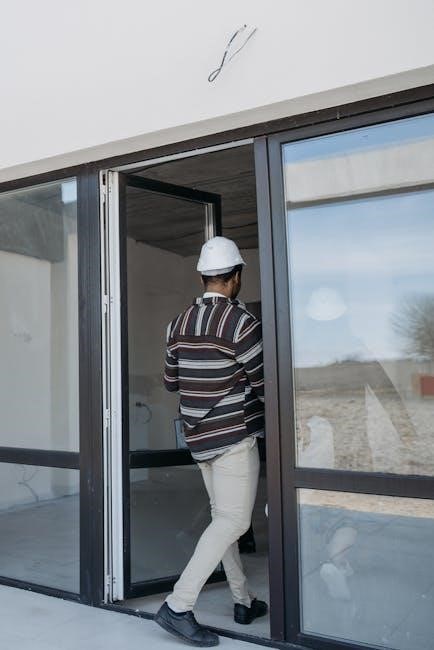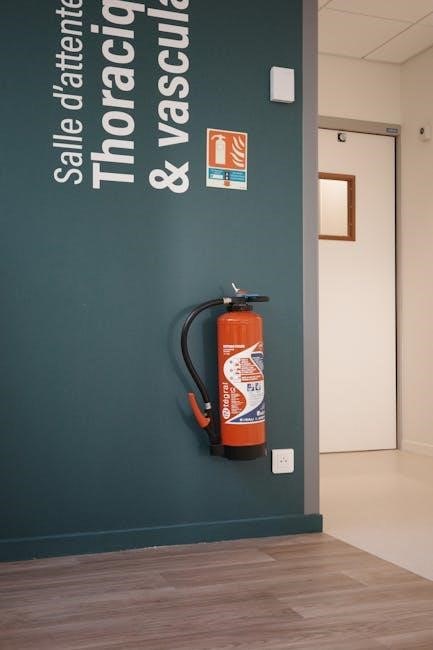A fire door inspection checklist is a critical tool for ensuring fire doors function properly, providing a structured approach to verifying compliance with safety standards like NFPA 80 and 101․
1․1 Importance of Fire Door Inspections
Fire door inspections are crucial for ensuring the safety of occupants and preventing the spread of fire and smoke․ They verify that doors function as intended, maintaining compartmentalization and providing escape routes․ Regular checks ensure compliance with regulations like NFPA 80 and 101, while identifying issues early to prevent failures; Properly maintained fire doors are essential for protecting lives and property, making inspections a cornerstone of fire safety management․
1․2 Overview of the Inspection Process
The inspection process involves systematically evaluating fire doors to ensure they meet safety standards․ It includes checking labels, frames, gaps, hardware, and seals, as well as documenting findings․ Responsible persons use checklists to verify compliance with regulations like NFPA 80 and 101․ Inspections vary in frequency, from weekly to annual, depending on risk levels and building requirements․ This structured approach ensures fire doors remain functional and reliable in emergencies․
1․3 Purpose of a Fire Door Inspection Checklist
The primary purpose of a fire door inspection checklist is to ensure fire doors are maintained and functioning correctly․ It guides evaluators through critical components like labels, gaps, and hardware, ensuring compliance with safety standards․ By documenting findings, the checklist helps identify issues, prevent fire spread, and protect lives․ Regular use of this tool is essential for maintaining fire safety and meeting legal obligations, ensuring all fire doors are reliable in emergencies․

Key Components of a Fire Door Inspection Checklist
A fire door inspection checklist includes critical components such as proper labeling, gap measurements, seal integrity, hardware functionality, and clearance checks to ensure compliance and safety․
2․1 Fire Door Labels and Certification
Fire door labels and certification are essential for verifying compliance with safety standards; Labels indicate fire ratings, while certification ensures doors meet regulatory requirements․ Inspections must confirm the presence of valid labels, typically located on the top or side of the door․ Missing or damaged labels can lead to non-compliance․ The checklist ensures these elements are verified, aligning with standards like NFPA 80 and 101, to maintain fire safety integrity and legal compliance․
2․2 Door and Frame Condition
The condition of the door and frame is critical for fire safety․ The checklist ensures that both are free from damage, warping, or rust․ Any structural issues could compromise the door’s ability to withstand fire․ Inspectors check for proper alignment and integrity, ensuring the door and frame form a secure barrier․ This step is vital for maintaining the door’s fire-resistant properties and overall performance during emergencies․
2․3 Gaps and Seals
Proper gaps between the door and frame are essential, typically 2mm to 4mm at the top and sides․ Seals must be intact, free from damage, paint, or varnish․ Intumescent and smoke seals should make full contact with the door leaf․ Any obstructions or gaps exceeding limits can compromise fire resistance․ Ensuring correct gaps and seals prevents smoke and fire spread, maintaining the door’s effectiveness in emergencies․ This step is critical for compliance and safety․
2․4 Hardware and Functionality
Hardware such as hinges, handles, and closing devices must function correctly․ Ensure all components are secure, undamaged, and free from obstruction․ The door should open and close smoothly, with automatic closers engaging properly․ Functionality checks include verifying that the door returns to its closed position and self-closing mechanisms work effectively․ Proper hardware ensures the door performs as intended during a fire, maintaining compartmentalization and safety․ Any malfunctions must be documented and addressed promptly to prevent failure․
2․5 Clearance and Proper Alignment
Proper clearance and alignment are crucial for fire door functionality․ The door must align correctly with the frame, ensuring even gaps of 2mm to 4mm around the edges․ Misalignment can prevent the door from sealing effectively, compromising fire resistance․ Check that the door closes fully and evenly, with no obstructions․ Improper clearance can lead to failure in containing smoke and fire, emphasizing the need for precise alignment to maintain safety and compliance with fire safety standards․
2․6 Intumescent Seals and Smoke Seals
Intumescent seals and smoke seals are vital components that expand when exposed to heat, preventing fire and smoke from spreading․ Inspect for proper installation, damage, or paint/varnish covering the seals․ Smoke seals must make full contact with the door frame․ Any obstructions or gaps compromise their effectiveness․ Ensure these seals are free from damage and functioning correctly to maintain fire resistance and compliance with safety standards like NFPA 80 and 101․

NFPA Standards for Fire Door Inspections
NFPA standards are critical guidelines for fire door inspections․ NFPA 80 and 101 outline specific criteria for inspecting components like labels, hardware, and seals, ensuring compliance and safety․
3․1 NFPA 80: Standard for Fire Doors
NFPA 80 provides detailed requirements for fire door assemblies, including inspection frequencies and criteria․ It ensures doors are tested, labeled, and maintained to withstand fire conditions, protecting lives and property․ This standard is essential for compliance, covering hardware, gaps, and seals․ Inspectors use NFPA 80 to verify components like intumescent seals and door alignment, ensuring all elements function as intended during emergencies․
3․2 NFPA 101: Life Safety Code Requirements
NFPA 101 sets criteria for fire doors in occupant safety, ensuring unobstructed exits and compliance with life safety standards․ It mandates annual inspections of fire doors to verify proper function and condition․ The checklist includes verifying labels, operation, and hardware, aligning with NFPA 80 requirements․ This ensures fire doors meet safety standards, protecting occupants during emergencies by maintaining clear pathways and effective fire containment․
The Role of the Responsible Person
The Responsible Person ensures fire door safety by documenting checks, completing one checklist per door, and verifying compliance with regulations to protect occupants and property effectively․
4․1 Who Should Conduct the Inspection?
The inspection should be conducted by the Responsible Person or a trained professional, ensuring compliance with fire safety regulations․ They must use a detailed checklist to verify all components, including labels, gaps, seals, and hardware․ The inspector should be knowledgeable about NFPA 80 and 101 standards․ Annual inspections must be performed by a certified professional to guarantee adherence to safety protocols․ Proper documentation is essential to maintain compliance and ensure fire door functionality․
4․2 Documentation and Reporting
Accurate documentation is crucial for maintaining fire door compliance․ A detailed report should be generated after each inspection, noting the condition of all components․ The Responsible Person must document findings, including any issues identified and corrective actions taken․ Records should be maintained for future reference and audits․ Proper reporting ensures transparency and accountability, helping to avoid legal penalties․ Digital tools can streamline this process, providing secure storage and easy access to inspection data․ This documentation is vital for compliance and safety․
Frequency of Fire Door Inspections
Fire doors must be inspected at least annually, with high-risk areas requiring more frequent checks․ Weekly or monthly inspections may be necessary for certain environments․
5․1 Weekly vs․ Monthly vs․ Annual Inspections
Fire doors must be inspected at least annually, but high-risk areas may require weekly or monthly checks․ Weekly inspections are ideal for doors in high-traffic or safety-critical locations, while monthly checks are suitable for moderate-risk environments․ Annual inspections are the minimum requirement for lower-risk areas․ The frequency may vary based on local regulations or specific conditions, ensuring compliance and optimal fire safety․ Adjusting the schedule helps maintain door functionality and safety standards effectively․
5․2 High-Risk Areas and Additional Checks
High-risk areas, such as hospitals or industrial facilities, require more frequent fire door inspections․ Additional checks include verifying door functionality, ensuring proper seals, and testing hardware operation․ These extra measures ensure compliance with safety standards and prevent potential hazards․ Regularity and thoroughness are crucial in high-risk environments to maintain fire safety and protect occupants effectively․
Common Issues Identified During Inspections
Common issues include damaged components, incorrect gaps, and non-compliant hardware, which can compromise fire safety․ These problems often result from wear and tear or improper maintenance․
6․1 Damaged or Missing Components
Damaged or missing components, such as broken door leaves, frames, or hinges, are common issues․ These defects can compromise a fire door’s ability to contain fires․ Missing intumescent seals or smoke seals also pose risks․ Identifying and addressing these problems is crucial to ensure the door functions correctly during emergencies․ Regular inspections help detect such issues early, preventing further damage and ensuring compliance with safety standards․ Prompt repairs are essential for maintaining fire safety integrity․
6․2 Incorrect Gaps or Seals
Incorrect gaps between the door and frame or faulty seals are critical issues․ Gaps exceeding 4mm or being uneven can compromise fire containment․ Intumescent and smoke seals must be free from damage or paint to function properly․ Incorrect gaps or damaged seals can allow smoke and fire to spread, defeating the door’s purpose; Regular inspections are essential to ensure gaps and seals meet safety standards and maintain fire resistance integrity․
6․3 Non-Compliant Hardware
Non-compliant hardware is a common issue during inspections․ Components like hinges, handles, and door closers must meet NFPA standards to ensure proper function․ If hardware is damaged, outdated, or incompatible, it can fail during a fire, compromising safety․ Identifying non-compliant hardware early is crucial to maintain fire door integrity․ Replacing such components with certified, standardized parts is essential to ensure compliance and reliability in emergency situations․

Solutions for Failed Inspections
Failed inspections require prompt action, including repairs, replacements, or scheduling professional maintenance to restore compliance and ensure fire door functionality and safety․
7․1 Repair vs․ Replacement Options
When fire doors fail inspections, repairs or replacements are necessary․ Minor issues like damaged seals or worn hardware can often be repaired․ However, significant damage, such as warped frames or extensive rot, may require full replacement․ The decision should align with NFPA standards and ensure compliance․ Always document the chosen solution and schedule follow-up inspections to confirm the door’s functionality and safety․
7․2 Scheduling Maintenance
Regular maintenance is crucial to ensure fire doors remain functional․ Schedule inspections based on usage and risk level, with high-traffic areas requiring more frequent checks․ Document all maintenance activities, including dates and findings, to maintain compliance․ Ensure follow-ups are planned to address any issues identified during inspections․ This proactive approach helps prevent failures and ensures fire doors are always ready to perform in emergencies․
Step-by-Step Guide to Conducting an Inspection
Begin with preparing the checklist, then systematically evaluate door labels, frame condition, gaps, hardware, and seals․ Document findings thoroughly to ensure compliance and safety standards are met․
8․1 Preparing for the Inspection
Begin by gathering necessary tools and documents, such as the fire door inspection checklist, a pen, and reference materials like NFPA 80․ Review the checklist to understand each step and ensure compliance with regulations․ Familiarize yourself with the building layout and identify all fire doors․ Check that all doors are accessible and free from obstructions․ Finally, ensure you have proper training or certification to conduct the inspection accurately and safely․
8․2 During the Inspection Process
Systematically evaluate each fire door using the checklist, starting with the fire door label and certification․ Check the door and frame condition for damage, gaps, and proper alignment․ Inspect seals, hardware functionality, and clearance․ Ensure intumescent and smoke seals are intact and free from damage or paint․ Test door operation, including closing speed and latching mechanisms․ Document findings, noting any deficiencies or areas requiring repair․ Use the checklist to ensure no critical components are overlooked during the process․
8․3 Post-Inspection Actions
After completing the inspection, document all findings on the checklist, noting any issues or repairs needed․ Address identified problems promptly, whether through repairs, replacements, or scheduling maintenance․ Ensure all corrective actions are completed by qualified personnel․ Maintain records of the inspection and any subsequent work for compliance and future reference․ Follow up to verify that all issues have been resolved and the fire door is fully functional and compliant with safety standards․
Digital Tools for Fire Door Inspections
Digital tools like software for checklist management and mobile apps streamline fire door inspections, enabling real-time reporting, improved accuracy, and better compliance tracking, enhancing overall fire safety management․
9․1 Software for Checklist Management
Software for fire door inspection checklists streamlines the process, offering digital templates, real-time updates, and cloud storage․ These tools enhance efficiency by allowing users to create, manage, and share checklists effortlessly․ Features like automated reporting and version control ensure accuracy and compliance with regulations․ Digital solutions also enable quick access to historical data, facilitating audits and maintaining a record of inspections․ This technology reduces administrative burdens and improves overall fire safety management․
9․2 Benefits of Digital Documentation
Digital documentation enhances organization, accessibility, and compliance for fire door inspections․ It allows for easy storage and retrieval of records, reducing paperwork․ Automated reporting and version control ensure accuracy and accountability․ Digital tools also enable real-time collaboration and sharing, making it simpler to track inspections and maintain compliance with regulations․ This approach streamlines record-keeping, supports audit preparedness, and improves overall fire safety management efficiency․
Compliance and Regulatory Requirements
Compliance with fire door regulations is essential for legal and safety reasons․ Adhering to NFPA standards ensures proper functionality and avoids penalties․ Regular inspections are mandatory․
10․1 Legal Obligations for Fire Safety
Legal obligations for fire safety mandate that fire doors must be regularly inspected and maintained to ensure compliance with regulations, such as NFPA 80 and 101․ Building owners and managers are responsible for ensuring all fire doors meet these standards․ Failure to comply can result in penalties, fines, and legal action․ Regular inspections and proper documentation are critical to fulfilling these obligations and ensuring safety․
10․2 Avoiding Penalties and Fines
Avoiding penalties and fines requires strict adherence to fire safety regulations․ Proper use of a fire door inspection checklist ensures compliance, preventing legal issues․ Regular inspections and documentation demonstrate commitment to safety standards, reducing liability risks․ Non-compliance can lead to significant fines and legal consequences, making proactive maintenance essential for safeguarding lives and property while avoiding financial repercussions․

Common Misconceptions About Fire Doors
Common misconceptions about fire doors often lead to inadequate maintenance; Many believe fire doors require no maintenance or that annual inspections are sufficient for compliance and safety․
11․1 Myths About Fire Door Maintenance
One common myth is that fire doors require minimal maintenance or that weekly checks are unnecessary․ Many believe fire doors are fail-safe or that closing them is enough․ Others think paint or minor damage won’t affect functionality; These misconceptions can lead to non-compliance and safety risks․ Regular inspections and proper maintenance are essential to ensure fire doors perform as intended during emergencies․ Always refer to a fire door inspection checklist for guidance․
11․2 Misunderstandings About Inspection Frequency
A common misconception is that fire door inspections are only required annually․ However, high-traffic or high-risk areas may need more frequent checks, such as weekly or monthly․ Some believe that fire doors are maintenance-free, but regular inspections are crucial to ensure functionality․ Failure to inspect as required can lead to non-compliance and safety hazards․ Always follow the guidelines outlined in a fire door inspection checklist to determine the appropriate inspection schedule for your facility․

Case Studies and Real-Life Examples
Real-life examples highlight the importance of fire door inspections․ For instance, a hotel prevented a fire hazard by identifying faulty seals, while an office building failed inspections due to poor maintenance, emphasizing the need for regular checks using a fire door inspection checklist․
12․1 Successful Fire Door Inspections
Successful fire door inspections ensure compliance with safety standards, preventing fire hazards․ A hotel used a checklist to identify faulty seals, while an office building maintained safety by addressing hardware issues promptly․ These cases demonstrate the checklist’s effectiveness in ensuring proper door function and compliance, protecting lives and property from fire risks․
12․2 Lessons Learned from Failed Inspections
Failed fire door inspections often reveal overlooked issues like damaged components or incorrect gaps․ A case involving worn intumescent seals highlighted the importance of thorough checks, while another instance of non-compliant hardware led to costly repairs․ These lessons emphasize the need for regular, detailed inspections and prompt corrective actions to ensure fire doors function as intended during emergencies․
A well-structured fire door inspection checklist ensures compliance with safety standards, protecting lives and property by maintaining fire doors’ integrity and functionality during emergencies․
13․1 Summary of Key Points
A fire door inspection checklist is essential for ensuring compliance with safety standards like NFPA 80 and 101․ It guides the evaluation of critical components such as labels, gaps, and hardware․ Regular inspections help identify issues like damaged seals or non-compliant frames, ensuring timely repairs․ The Responsible Person must document findings and maintain compliance to avoid penalties․ Proper fire door maintenance is vital for preventing fire spread and protecting lives and property․
13․2 Final Thoughts on Fire Door Safety
Fire door safety is paramount for protecting lives, property, and ensuring regulatory compliance․ Regular inspections, supported by a comprehensive checklist, are vital to maintain functionality and integrity․ Neglecting fire door maintenance can lead to severe consequences, including penalties and compromised safety․ Adherence to standards like NFPA 80 and 101 ensures fire doors perform as intended during emergencies․ Proactive inspection and timely repairs are essential for safeguarding against fire hazards and upholding a safe environment․

Leave a Reply